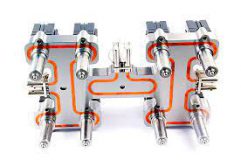Welcome to the second part of our blog series on the many advantages of hot runner systems. If you missed Part 1, don’t worry; we won’t hold it against you.
Key advantage 4: Minimal material wastage
To reduce material wastage during the manufacturing process, hot runner systems offer a cost-effective solution. By eliminating cold runner scrap, these systems minimize material waste and provide better control over mold filling, resulting in higher-quality parts. Additionally, hot runner systems can help reduce the risk of defects such as sink marks and warping, making them well-suited for high-volume production runs.
The minimal material wastage associated with hot runner systems also leads to cost savings, boosting profitability for manufacturers across various industries. Overall, hot runner systems are an ideal choice for those looking to reduce material waste and improve their bottom line without compromising on product quality.
Key advantage 5: Multiple gates for complex designs
When it comes to designing complex parts, hot runner systems offer an advantage over cold runner systems by allowing for multiple gates. This means that the flow of molten plastic can be better controlled, resulting in higher quality parts with fewer defects or imperfections.
In addition, hot runners provide greater design flexibility, enabling manufacturers to create more intricate shapes and designs than what would be possible with a traditional cold runner system. Multiple gates also mean faster production times and reduced material waste, making hot runner systems an ideal choice for high volume production runs.
Key advantage 6: Consistent part production
Consistency is key in any manufacturing process, and hot runner systems can provide just that for part production. By eliminating cold runners, hot runner systems reduce material waste and increase efficiency, ensuring that each molded part is identical. This consistency leads to higher quality products and increased customer satisfaction.
Additionally, the use of hot runners allows for greater design flexibility than traditional molding methods, meaning that manufacturers have more options when it comes to creating complex shapes or unique products. Overall, the consistent part production offered by hot runner systems can result in significant cost savings and improved product quality.
Key advantage 7: Versatile application in various industries
Hot runner systems have become increasingly popular in various industries due to their versatility and advantages. They allow for greater flexibility in mold design and cavity layout, resulting in more complex designs and shapes. The elimination of cold runners not only saves on material waste but also reduces the occurrence of visual defects in the final product.
Hot runner systems provide consistent temperature control, leading to better part quality and faster color changes during production. These benefits ultimately lead to cost savings, increased productivity, and improved customer satisfaction. The versatility of hot runner systems makes them an ideal choice for various applications in industries such as automotive, medical, and consumer goods manufacturing.
Key advantage 8: Reduced costs and improved product quality
When it comes to mold making technology, hot runner systems offer several advantages, including reduced costs and improved product quality. By eliminating the need for runners, hot runner systems greatly reduce material waste and overall costs. Additionally, without cold runners present, there are no defects or inconsistencies in the final product, which ultimately improves product quality.
These systems also allow for faster and more efficient molding, improving cycle times and allowing for greater design flexibility. With all these benefits combined, hot runner systems provide a cost-effective and efficient solution for mold making technology.
What are Hot Runner’s Advantages and Disadvantages?
Hot runner systems offer several advantages, including reduced waste, faster cycle times, and improved part quality. However, they can be more expensive than traditional molds. It is also important to note that prolonged exposure to high temperatures can lead to degradation or discoloration of the plastic material.
To ensure optimum performance, proper maintenance, and cleaning are necessary. Despite some drawbacks, hot runner systems remain a popular choice for many injection molding applications due to their efficiency and effectiveness.
Conclusion:
Hot runner systems offer several advantages over traditional cold runner systems. They are cost-effective, reduce cycle time, improve part quality, and minimize material wastage. Additionally, they allow for multiple gates for complex designs, consistent part production, and versatile application across various industries.
However, it is important to note that hot runner systems also have disadvantages such as maintenance and higher initial costs. Overall, the benefits outweigh the drawbacks for most mold-making applications. To learn more about hot runner systems and how they can benefit your manufacturing process, contact us today.
 The three key factors affecting mold cost have nothing to do with materials!
The three key factors affecting mold cost have nothing to do with materials!  8 Key Advantages of Hot Runner Systems – Part 1
8 Key Advantages of Hot Runner Systems – Part 1  Plastic Injection Mold Material Guide – Advantages & Applications Of 20 Common Injection Molding Materials
Plastic Injection Mold Material Guide – Advantages & Applications Of 20 Common Injection Molding Materials  Hot Runner Vs Cold Runner Mold – What’s The Difference Between Hot Runner & Cold Runner Injection Molding
Hot Runner Vs Cold Runner Mold – What’s The Difference Between Hot Runner & Cold Runner Injection Molding